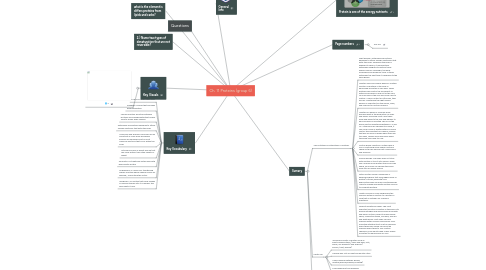
1. General Info
2. Questions
3. Key Visuals
3.1. 3
4. Key Vocabulary
4.1. THE MAILLARD REACTION
4.2. Aldehyde: Alcohol that has been dehydrogenated
4.3. Maillard reaction: Reaction between proteins and carbohydrates that causes food to brown when cooked
4.4. Antibodies:Are proteins designed to attack foreign substance that enter the body.
4.5. Hormones and Enzyme: hormones are an important of many body processes. Enzyme are necessary part of most chemical reactions that occur within the body
4.6. Triticale:is across of wheat and rye that has more protein than other variety of wheat.
4.7. Amaranth: is a traditional Aztec grain with high-quality protein
4.8. Anaphylaxis: Is a serve life -threatening allergic reaction where swelling closes air passage , suffocating the victim.
4.9. myoglobin: Is a protein that holds oxygen in muscles tissues until it is needed. this give meats it color
5. what is the element is differs proteins from lipids and carbs?
6. 2.) Name two types of denaturation that are not reversible?
7. Protein is one of the energy nutrients
8. Page numbers
8.1. 323-327
9. Sumary
9.1. The Nutritional Contributions of Proteins
9.1.1. Fight disease: Antibodies are proteins designed to attack foreign substances that enter the body. Whenever the body is exposed to germs, it manufactures antibodies designed to destroy those specific germs. Amazingly, the body remembers and produces more of those antibodies the next time it is exposed to the same germs.
9.1.2. Maintain fluid and Mineral Balance: Another function of proteins in the body is performed by protein in cell walls. These proteins help control the movement of water and minerals in and out of the cells. To much fluid in the cells will cause cells to rupture. If cells contain too little fluid, they will die. Maintaining the right mineral balance is important for the nerves, brain, and muscles to function properly.
9.1.3. Maintain pH balance: Normally body process result in the production of acids and bases. The blood must carry these acids and bases to the liver and kidneys to be processed or excreted. The pH of the blood must be maintained between 7.4 and 7.6. If the blood pH changes too much, it can cause coma or death.Proteins in blood control this important pH balance, buffers that pick up acids or bases when there are too many, release acids and bases when the blood level drop too low
9.1.4. Control Bodily Functions: Proteins play a role in controlling many bodily functions. These do this by being a part of hormones and enzymes
9.1.5. Provide Energy: The body does not store extra protein or turn it into muscle. When you consume more protein than your body needs, your body can change the amino acids into an energy source.
9.1.6. Future Protein Needs: Researcher is developing grains that yield higher levels of protein( Triticale,Amaranth) and high-protein grain sources is biotechnology. Hope to change incomplete protein sources to complete proteins
9.1.7. Health Concerns: Food allergies are the immune system's reaction to a protein in food that is mistaken for a harmful substance.
9.1.8. Support growth and repair: The most important function of protein in the body is to provide nitrogen and amino acids for growth and repair. Protein is used to make muscle fibers, connective tissue, cell walls, and red and white blood. Most body cells are replaced within a seven-year period. Cells lining the intestinal tract must be replaced every three days. Blood cells must be replaced every three to four months. Therefore, even adults need a daily supply of protein to replace worn of cells
9.2. Health Tip
9.2.1. Including a variety of protein such as plant-based proteins ( bean and peas, nuts, seeds, soy products) and seafood ( salmon, trout, herring)
9.2.2. Choose lean cuts of meat and poultry often
9.2.3. Using cooking methods: grilling, roasting,broiling,braising,or baking)
9.2.4. Avoid adding fat and breading
9.3. Myoglobin is a protein that holds oxygen in muscle tissue until it is needed. It gives meat color and responsible for the color changes that take place in meat during cooking
9.3.1. Fresh meat has a red color because myoglobin is red when exposed to oxygen. Pork is lighter than beef because it contains less myoglobin

